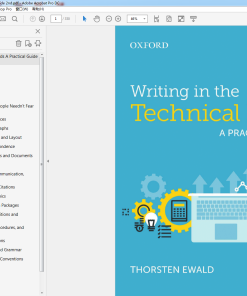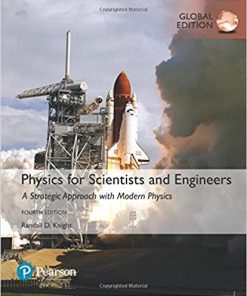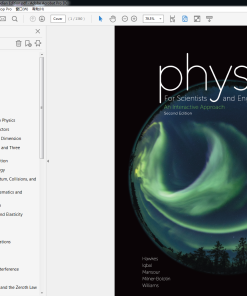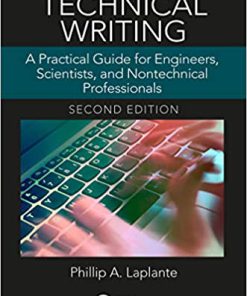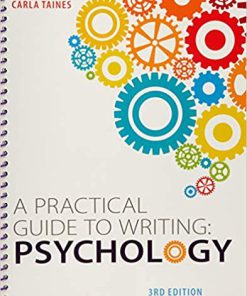(eBook PDF) Technical Writing: A Practical Guide for Engineers, Scientists, and Nontechnical Professionals, Second Edition
$50.00 Original price was: $50.00.$35.00Current price is: $35.00.
(eBook PDF) Technical Writing: A Practical Guide for Engineers, Scientists, and Nontechnical Professionals, Second Edition – Instant Download
(eBook PDF) Technical Writing: A Practical Guide for Engineers, Scientists, and Nontechnical Professionals, Second Edition – Digital Ebook – Instant Delivery Download

product details:
- ISBN-10 : 1138628107
- ISBN-13 : 978-1138628106
- Author: Phillip A. Laplante
Technical Writing: A Practical Guide for Engineers, Scientists, and Nontechnical Professionals, Second Edition enables readers to write, edit, and publish materials of a technical nature, including books, articles, reports, and electronic media. Written by a renowned engineer and widely published technical author, this guide complements traditional writer’s reference manuals on technical writing through presentation of first-hand examples that help readers understand practical considerations in writing and producing technical content. These examples illustrate how a publication originates as well as various challenges and solutions.
The second edition contains new material in every chapter including new topics, additional examples, insights, tips and tricks, new vignettes and more exercises. Appendices have been added for writing checklists and writing samples. The references and glossary have been updated and expanded. In addition, a focus on writing for the nontechnical persons working in the technology world and the nonnative English speaker has been incorporated. Written in an informal, conversational style, unlike traditional college writing texts, the book also contains many interesting vignettes and personal stories to add interest to otherwise stodgy lessons.
table of contents:
Chapter 1: The Nature of Technical Writing
1.1 Introduction
1.2 Who Writes Technical Documentation?
1.3 Taxonomy of Technical Writing
1.4 Technical Reporting
1.5 Business Communications
1.6 Scientific Writing
1.7 Exercises
1.8 References
Chapter 2: Technical Writing Basics
2.1 Introduction
2.2 Structuring Your Writing
2.3 Positioning Your Writing
2.4 Choosing the Right Words
2.5 Avoiding Traps
2.6 Making Your Technical Writing More Interesting
2.7 The 5 Cs of Technical Writing
2.8 Referencing
2.9 Exercises
2.10 References
Chapter 3: The Writing Process
3.1 Introduction
3.2 The Traditional Writing Process
3.3 Environment
3.4 Dealing with Writer’s Block
3.5 Meeting Deadlines
3.6 Writing Tools
3.7 Permissions and Plagiarism
3.8 Making Your Writing Understandable to All
3.9 Exercises
3.10 References
Chapter 4: Scientific Writing
4.1 Introduction
4.2 Technical Reports
4.3 Tutorials
4.4 Opinion
4.5 Research Papers
4.6 Reviews of books, papers, and reports
4.7. Exercises
4.8 References
Chapter 5: Business Communications
5.1 Introduction
5.2 Resumes
5.3 Transmittal Letters
5.4 Writing letters of reference
5.5 Memos
5.6 Meetings, Agendas and Minutes
5.7 Customer Relations Writing
5.8 Press Releases
5.9 Presentations
5.10 Marketing and sales materials
5.11 Exercises
5.12 References
Chapter 6: Technical Reporting
6.1 Introduction
6.2 Technical Procedures
6.3 Proposals
6.4 Panel Sessions
6.5 Strategic Plans and Planning
6.6 Problem Reports
6.7 User Manuals
6.8 Exercises
6.9 References
Chapter 7: Using Graphical Elements
7.1 Breaking up the Monotony
7.2 Modeling Ideas with Graphics
7.3 Selecting the best model for a schedule
7.4 Dealing with Figures
7.5 Dealing with Tables
7.6 Dealing with equations
7.7 Dealing with Dynamic Content
7.8 Exercises
7.7 References
Chapter 8: Publishing Your Work
8.1 Introduction
8.2 Making a living as a writer
8.3 The Review Process
8.4 Handling Rejection
8.5 Open Access Publishing
8.6 Self-publishing
8.7 Exercises
8.8 References
Chapter 9: Writing For E-Media
9.1 Introduction
9.2 Email can be Dangerous
9.3 E-newsletters
9.4 Blogging
9.5 Social Networks
9.5 E-Magazines
9.7 E-Readers
9.8 Online Courses
9.9 Exercises
9.9 References
Chapter 10: Writing with Collaborators
10.1 Introduction
10.2 Writing in Different Voices
10.3 Very Large Collaborative Writing Projects
10.4 Behavior of Groups
10.5 Other Paradigms for Team Building
10.6 Antipatterns in Organizations
10.7 Exercises
10.8 References
people also search:
You may also like…
Computers & Technology
(eBook PDF) Writing in the Technical Fields A Practical Guide 2nd Canadian Edition



